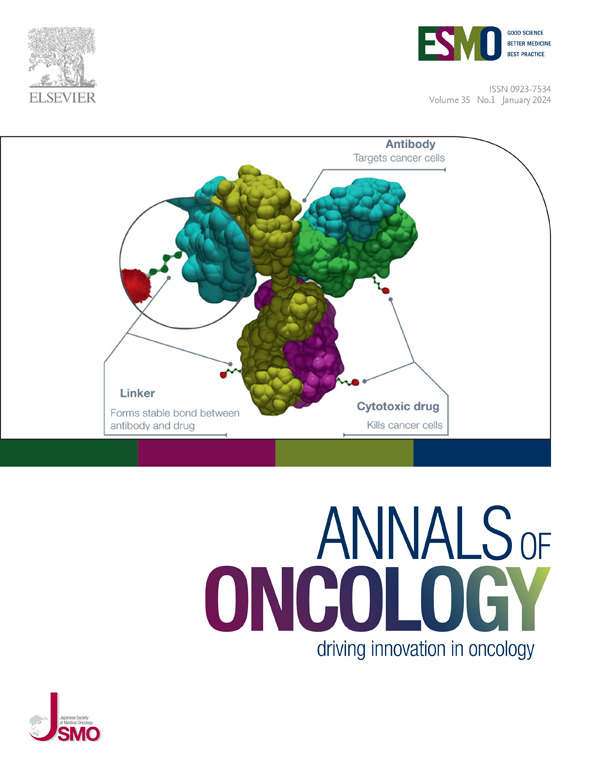霍奇金淋巴瘤患者无进展生存期与总生存期的相关性:随机GHSG试验中个体患者数据的综合分析
IF 56.7
1区 医学
Q1 ONCOLOGY
引用次数: 0
摘要
背景:我们旨在评估经典霍奇金淋巴瘤(HL)一线治疗后无进展(PFS)和总生存(OS)的相关性,以及PFS作为OS替代参数的潜力。患者和方法:我们分析了1993年1月至2018年8月期间9项随机III期试验(GHSG HD7-HD15)中接受多化疗治疗期间和之后获得的个体患者数据。采用Cox比例风险(PH)回归和线性加权最小二乘回归评价16个试验处理对试验水平PFS和OS的影响。在患者水平上,根据Wei-Lin-Weissfeld方法,应用多个终点的边际Cox PH模型。结果:10605例患者中,分别有1682例PFS和1064例OS事件发生。在试验水平上,治疗效果与PFS和OS有很强的相关性(加权Pearson r= 0.72, R2= 0.54, P< 0.001)。在患者水平上,治疗效果对PFS和OS的中度至强相关性得到证实,Pearson r范围为0.61 - 0.85 (P均< 0.001),总r= 0.74。考虑不同类型的试验处理和历代试验的历史进展的回归模型达到非常强的相关性(R2= 0.93)。将该模型应用于当代一线ECHELON-1试验的数据,可以从PFS预测OS(预测ln[HR(OS)]= -0.68,而观察ln[HR(0.59)]= -0.53)。结论:在HL的一线试验中,PFS和OS以及治疗效果和预后对PFS和OS的影响是强相关的。因此,PFS在很大程度上预测了治疗对OS的影响,并且在OS能够可靠评估之前很多年。本文章由计算机程序翻译,如有差异,请以英文原文为准。
Correlation between progression-free and overall survival in patients with Hodgkin lymphoma: a comprehensive analysis of individual patient data from randomized German Hodgkin Study Group (GHSG) trials☆
Background
This study aimed to evaluate the correlation between progression-free (PFS) and overall survival (OS) after first-line treatment of classical Hodgkin lymphoma (HL) and to assess the potential of PFS as a surrogate parameter for OS.
Patients and methods
We analyzed individual patient data collected during and after treatment with polychemotherapy in nine randomized phase III trials [German Hodgkin Study Group (GHSG) HD7-HD15] between January 1993 and August 2018. The effects of 16 experimental treatments on PFS and OS at the trial level were evaluated using Cox proportional hazards (PH) regression and linear weighted least squares regression. At the patient level, marginal Cox PH models for multiple endpoints were applied using the Wei–Lin–Weissfeld method.
Results
At least one PFS and OS event was recorded in 1682 and 1064 of 10 605 patients, respectively. At the trial level, there was a strong correlation between treatment effects on PFS and OS (weighted Pearson r = 0.72, R2 = 0.54, P < 0.001). At the patient level, a moderate to strong correlation between treatment effects on PFS and OS was observed, with Pearson r values ranging between 0.61 and 0.85 (each P < 0.001) and an overall r = 0.74. A regression model that accounted for different types of experimental treatments and historical progress across trial generations achieved a very strong correlation (R2 = 0.93). When applied to data from the contemporary first-line ECHELON-1 trial, this model successfully predicted OS from PFS {prognosticated ln[HR(OS)] = −0.68 as compared with observed ln[HR(0.59)] = −0.53}.
Conclusion
In first-line trials of HL, PFS and OS, as well as treatment effects and prognostic effects on these endpoints, are strongly correlated. PFS serves as a strong predictor of treatment effects on OS, providing valuable insights many years before OS can be reliably assessed.
求助全文
通过发布文献求助,成功后即可免费获取论文全文。
去求助
来源期刊

Annals of Oncology
医学-肿瘤学
CiteScore
63.90
自引率
1.00%
发文量
3712
审稿时长
2-3 weeks
期刊介绍:
Annals of Oncology, the official journal of the European Society for Medical Oncology and the Japanese Society of Medical Oncology, offers rapid and efficient peer-reviewed publications on innovative cancer treatments and translational research in oncology and precision medicine.
The journal primarily focuses on areas such as systemic anticancer therapy, with a specific emphasis on molecular targeted agents and new immune therapies. We also welcome randomized trials, including negative results, as well as top-level guidelines. Additionally, we encourage submissions in emerging fields that are crucial to personalized medicine, such as molecular pathology, bioinformatics, modern statistics, and biotechnologies. Manuscripts related to radiotherapy, surgery, and pediatrics will be considered if they demonstrate a clear interaction with any of the aforementioned fields or if they present groundbreaking findings.
Our international editorial board comprises renowned experts who are leaders in their respective fields. Through Annals of Oncology, we strive to provide the most effective communication on the dynamic and ever-evolving global oncology landscape.
 求助内容:
求助内容: 应助结果提醒方式:
应助结果提醒方式:


